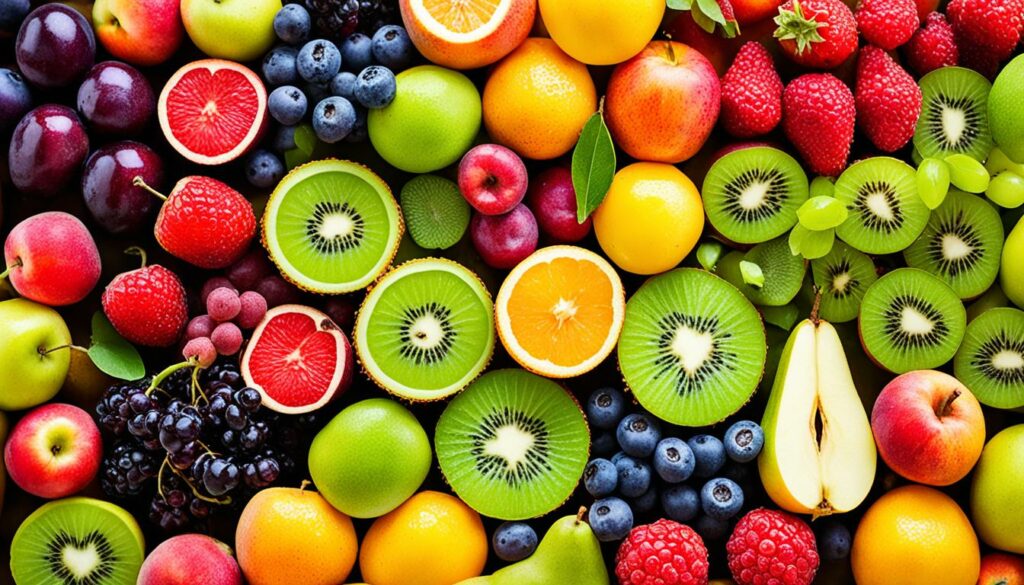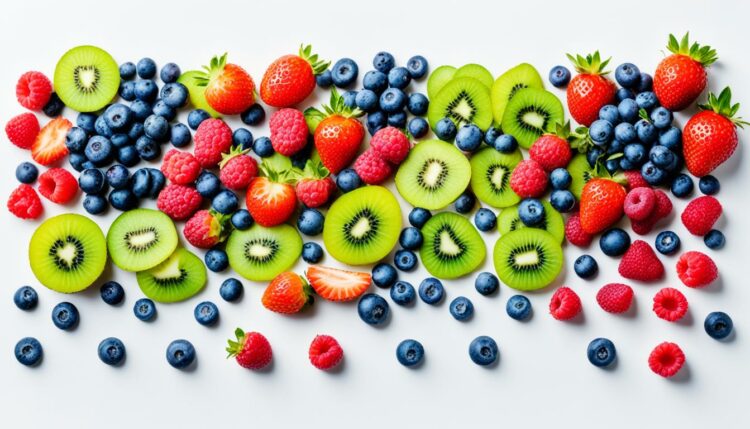When it comes to snacking, choosing the right fruits can make a significant difference. Low-glycemic fruits, also known as low GI fruits, have a minimal impact on blood sugar levels due to their slow digestion and absorption.
Incorporating low glycemic fruits into your diet can be beneficial for weight management, blood sugar control, and increased energy.
Key Takeaways:
- Low-glycemic fruits are carbs that are digested and absorbed slowly.
- They help stabilize blood sugar levels and promote steady energy.
- Including low-glycemic fruits in your diet can aid in weight management.
- Low GI fruits are suitable for individuals with diabetes.
- Low glycemic fruits provide essential nutrients and antioxidants for overall health.
What Are Low GI Fruits?
Low-glycemic index (GI) fruits play a significant role in maintaining stable blood sugar levels and promoting overall health.
These fruits are rich in fiber and have a low glycemic index, meaning they are slowly digested and absorbed, resulting in a gradual rise in blood sugar levels. By including low GI fruits in your diet, you can enjoy the benefits of sustained energy, essential nutrients, and better blood sugar control.
Fiber, a key component of low GI fruits, plays a crucial role in regulating blood sugar levels. It slows down digestion and prevents rapid spikes in glucose, providing a steady source of energy. Additionally, the fiber in low GI fruits contributes to a feeling of fullness, aiding in weight management.
“Including low GI fruits in your diet can help stabilize blood sugar levels, maintain energy, and provide essential nutrients.”
Here is an example of a low GI fruit:
| Fruit | Glycemic Index (GI) |
|---|---|
| Apple | 36 |
Incorporating low GI fruits like apples in your diet can support your overall well-being by providing essential vitamins, minerals, and antioxidants. These fruits are not only delicious but also offer numerous health benefits, including improved digestion, enhanced immune function, and reduced risk of chronic diseases.
Remember, incorporating a variety of low GI fruits into your diet is key to enjoying the full range of nutritional benefits they offer. By choosing these fruits, you can nourish your body while maintaining stable blood sugar levels and promoting optimal health.
9 Low-Glycemic Index Fruits You Should Consider
When it comes to maintaining stable blood sugar levels and making healthier dietary choices, incorporating low-glycemic index (GI) fruits into your diet can be a game-changer.
These fruits have a low GI score, meaning they cause a slow and gradual increase in blood sugar levels. They are packed with essential nutrients, fiber, and antioxidants, making them excellent choices for weight management, diabetes control, and overall health.
Here is a list of 9 low-GI fruits that you should consider adding to your shopping list:
- Oranges (GI: 45)
- Apples (GI: 36)
- Berries (GI: 28-40)
- Grapefruit (GI: 26)
- Mangos (GI: 50)
- Pomegranates (GI: 55)
- Pears (GI: 38)
- Peaches (GI: 28)
- Apricots (GI: 34)
These low-GI fruits offer a myriad of health benefits. They are rich in vitamin C, fiber, and antioxidants, which support immune function, digestion, and overall well-being. Incorporating these fruits into your diet can help you feel satisfied, manage your weight, and keep your blood sugar levels under control.

Why Choose Low-GI Fruits?
Low-GI fruits are excellent options for individuals with diabetes or those looking to maintain stable blood sugar levels.
The slow digestion and absorption of these fruits help prevent blood sugar spikes and crashes, providing sustained energy throughout the day. Moreover, the fiber content in low-GI fruits aids in digestion, promotes satiety, and supports heart health.
Including low-GI fruits in your diet can help stabilize blood sugar, manage weight, and improve overall health.
Whether you’re aiming to lose weight, control diabetes, or simply want to make healthier snack choices, these low-GI fruits should be on your radar. Their delicious flavors and nutritional benefits make them a perfect addition to your daily meals and snacks.
High Glycemic Index Fruits You Should Avoid
While low GI fruits are recommended for managing blood sugar, it’s important to be aware of high GI fruits that can cause rapid spikes in blood sugar levels. Consuming these fruits in moderation or avoiding them altogether can help maintain stable blood sugar levels and prevent any undesirable effects.
“It’s important to be mindful of the fruits you choose, particularly if you are monitoring your blood sugar levels.”
Here are two high glycemic index fruits that you should be cautious of:
| Fruit | Glycemic Index |
|---|---|
| Overripe Bananas | 70 |
| Watermelon | 72 |
These fruits have a high glycemic index, meaning they can cause blood sugar spikes when consumed. While they may be delicious, it’s best to opt for low GI alternatives to support a healthier snack option.
Consider substituting them with these low GI alternatives:
- Unripe Bananas (GI: 30)
- Cantaloupe (GI: 65)
The Importance of Choosing Low GI Fruits
By making conscious choices and selecting low GI fruits, you can better manage your blood sugar levels and reduce the risk of experiencing blood sugar spikes.
Incorporating low GI fruits into your diet not only promotes healthier snacking but also aids weight management, improves energy levels, and supports overall well-being.
Remember, knowledge about the glycemic index of fruits can empower you to make informed decisions about your diet, allowing you to maintain a healthier and more balanced lifestyle.
The Role of Fiber in Fruits
Fiber plays a crucial role in fruits, especially those with high fiber content. The presence of fiber in fruits helps slow down digestion, which in turn decreases the risk of rapid blood sugar spikes. But the benefits of fiber in fruits go beyond blood sugar control.
Fiber is known to contribute to bathroom regularity and promote satiety, helping to manage weight and prevent overeating. Moreover, consuming fiber-rich fruits can reduce the risk of heart disease and certain cancers due to their ability to lower cholesterol levels and support overall digestive health.
To maximize the benefits of fiber in fruits, it is recommended to include a variety of them in your diet. Some fruits that are particularly high in fiber include:
- Apples
- Pears
- Berries
- Oranges
- Mangos
These fruits not only provide a delicious and refreshing treat but also offer the added benefits of fiber, which can improve digestion, support weight management, and enhance overall health.

“Including fruits with high fiber content in your diet can help manage weight, improve digestion, and support overall health.”
Glycemic Index vs. Glycemic Load
The glycemic index (GI) and glycemic load (GL) are two measures used to assess the impact of food on blood sugar levels. Understanding the difference between these two concepts can help individuals make informed dietary choices and effectively manage blood sugar levels.
The glycemic index measures how quickly a specific food affects blood sugar levels. It ranks foods on a scale of 0-100, with higher numbers indicating a higher impact on blood sugar.
Foods with a high glycemic index are quickly digested and cause rapid spikes in blood sugar levels, while foods with a low glycemic index are digested and absorbed more slowly, resulting in a gradual rise in blood sugar.
The glycemic load, on the other hand, takes into account portion sizes and provides a more realistic view of a food’s effect on blood glucose levels.
The glycemic load categorizes foods as low, medium, or high based on their glycemic impact. It considers both the glycemic index and the quantity of carbohydrates present in a serving of food.
“The glycemic load provides a more accurate assessment of a food’s effect on blood sugar levels by considering both the glycemic index and portion size.”
While the glycemic index focuses solely on the quality of carbohydrates, the glycemic load provides a more comprehensive view. By considering both the glycemic index and portion size, the glycemic load helps individuals understand the overall impact of a food on blood sugar levels.
Here is a comparison between the glycemic index and glycemic load:
| Glycemic Index | Glycemic Load |
|---|---|
| Measures how quickly a food affects blood sugar levels | Takes into account both the glycemic index and portion size |
| Ranks foods on a scale of 0-100 | Categorizes foods as low, medium, or high |
| High GI foods cause rapid spikes in blood sugar | High GL foods can also cause blood sugar spikes if consumed in large quantities |
| Focuses on the quality of carbohydrates | Provides a more comprehensive view of a food’s impact on blood sugar |
By understanding both the glycemic index and glycemic load, individuals can make better dietary choices to manage their blood sugar levels effectively. It is essential to incorporate a combination of low glycemic index and low glycemic load foods into your diet for optimal blood sugar control and overall health.
Conclusion
Incorporating low glycemic fruits into your diet can have numerous benefits for your health and well-being. By choosing fruits with a low glycemic index (GI) and avoiding high GI fruits, you can maintain stable blood sugar levels, support weight management, and increase energy levels throughout the day.
Low glycemic fruits, such as oranges, apples, berries, grapefruits, mangos, pomegranates, pears, peaches, and apricots, offer a range of essential nutrients, including vitamin C, fiber, and antioxidants. These fruits are suitable for various purposes, including weight loss, diabetes management, and overall health improvement.
To incorporate low glycemic fruits into your diet, consider adding them as snacks or including them in your meals. Pairing low GI fruits with protein, healthy fats, and fiber can help create balanced and nutritious meals that provide long-lasting energy and satiety.
By making low glycemic fruits a regular part of your diet, you can enjoy the benefits of stable blood sugar levels, improved nutrition, and a healthier lifestyle. So start exploring the wide variety of low GI fruits available and take a step towards better health today!
FAQ
What are low glycemic fruits?
Low glycemic fruits are carbohydrates that have a low glycemic index, meaning they are digested and absorbed slowly, resulting in a gradual rise in blood sugar levels.
What are the health benefits of low glycemic fruits?
Low glycemic fruits have several health benefits, including weight management, blood sugar control, increased energy levels, and providing essential nutrients.
Can low GI fruits help with weight loss?
Yes, low glycemic fruits are suitable for weight loss as they help stabilize blood sugar levels and provide essential nutrients while being lower in calories compared to high glycemic fruits.
Can low glycemic fruits be beneficial for diabetes management?
Absolutely, incorporating low GI fruits into a diabetes management plan can help regulate blood sugar levels and prevent rapid spikes in glucose.
Which low glycemic fruits are good for increased energy levels?
Low GI fruits such as oranges, apples, berries, and peaches can provide sustained energy due to their slow digestion and gradual release of glucose into the bloodstream.
What are some examples of low GI fruits?
Some examples of low glycemic index fruits include oranges, apples, berries, grapefruit, mangos, pomegranates, pears, peaches, and apricots.
Are there any high glycemic fruits I should avoid?
It is best to limit or avoid high glycemic fruits that can cause rapid spikes in blood sugar levels, such as overripe bananas and watermelon.
What role does fiber play in low glycemic fruits?
Fiber in fruits slows down digestion, decreases the risk of rapid blood sugar spikes, improves digestion, promotes satiety, and contributes to overall health, including weight management and lowering the risk of heart disease and certain cancers.
What is the difference between glycemic index and glycemic load?
The glycemic index (GI) measures how quickly a specific food affects blood sugar levels, while the glycemic load (GL) takes into account portion sizes and provides a more realistic view of the food’s effect on blood glucose levels.
How can low glycemic fruits be incorporated into a healthy diet?
You can incorporate low glycemic fruits into your diet by including them in your meals, snacks, and smoothies, or as toppings for yogurt or oatmeal. Pair them with protein, healthy fats, and fiber for balanced and nutritious meals.




